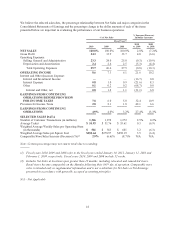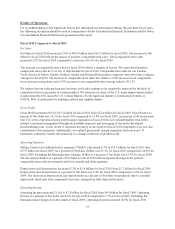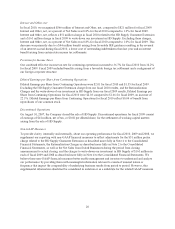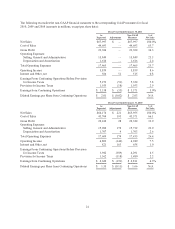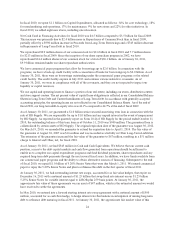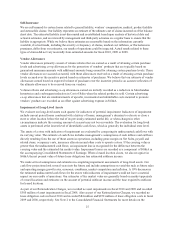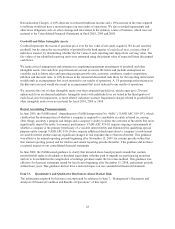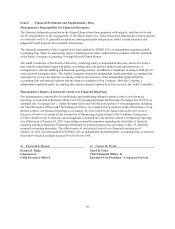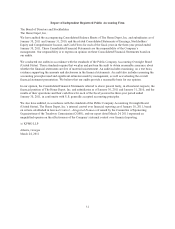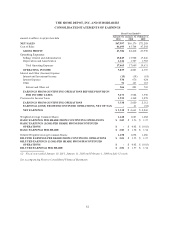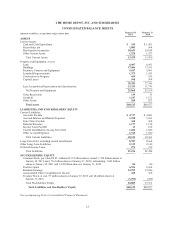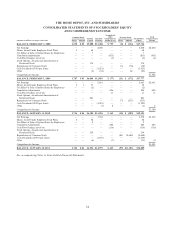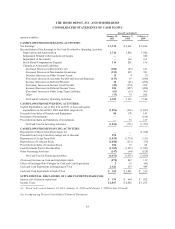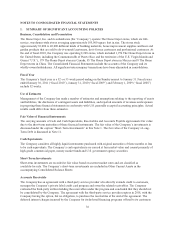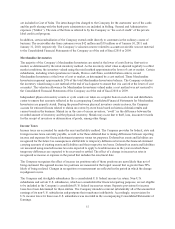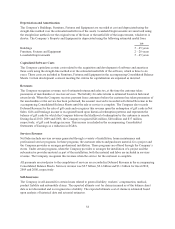Home Depot 2010 Annual Report Download - page 34
Download and view the complete annual report
Please find page 34 of the 2010 Home Depot annual report below. You can navigate through the pages in the report by either clicking on the pages listed below, or by using the keyword search tool below to find specific information within the annual report.
Rationalization Charges. A 10% decrease in estimated sublease income and a 10% increase in the time required
to sublease would not have a material impact on our results of operations. We also recorded impairments and
other lease obligation costs on other closings and relocations in the ordinary course of business, which were not
material to the Consolidated Financial Statements in fiscal 2010, 2009 and 2008.
Goodwill and Other Intangible Assets
Goodwill represents the excess of purchase price over the fair value of net assets acquired. We do not amortize
goodwill, but do assess the recoverability of goodwill in the third quarter of each fiscal year, or more often if
indicators warrant, by determining whether the fair value of each reporting unit supports its carrying value. The
fair values of our identified reporting units were estimated using the present value of expected future discounted
cash flows.
We make critical assumptions and estimates in completing impairment assessments of goodwill and other
intangible assets. Our cash flow projections look several years into the future and include assumptions on
variables such as future sales and operating margin growth rates, economic conditions, market competition,
inflation and discount rates. A 10% decrease in the estimated discounted cash flows for the reporting units tested
would result in an impairment that is not material to our results of operations. A 1.0 percentage point increase in
the discount rate used would also result in an impairment that is not material to our results of operations.
We amortize the cost of other intangible assets over their estimated useful lives, which range up to 20 years,
unless such lives are deemed indefinite. Intangible assets with indefinite lives are tested in the third quarter of
each fiscal year for impairment, or more often if indicators warrant. Impairment charges related to goodwill and
other intangible assets were not material for fiscal 2010, 2009 or 2008.
Recent Accounting Pronouncements
In June 2009, the FASB issued “Amendments to FASB Interpretation No. 46(R)” (“FASB ASC 810-10”), which
clarifies that the determination of whether a company is required to consolidate an entity is based on, among
other things, an entity’s purpose and design and a company’s ability to direct the activities of the entity that most
significantly impact the entity’s economic performance. FASB ASC 810-10 requires ongoing reassessments of
whether a company is the primary beneficiary of a variable interest entity and eliminates the qualifying special
purpose entity concept. FASB ASC 810-10 also requires additional disclosures about a company’s involvement
in variable interest entities and any significant changes in risk exposure due to that involvement. This guidance
was effective for annual reporting periods beginning after November 15, 2009, for interim periods within that
first annual reporting period, and for interim and annual reporting periods thereafter. This guidance did not have
a material impact on our consolidated financial statements.
In June 2008, the FASB issued guidance to clarify that unvested share-based payment awards that contain
nonforfeitable rights to dividends or dividend equivalents (whether paid or unpaid) are participating securities
and are to be included in the computation of earnings per share under the two-class method. This guidance was
effective for financial statements issued for fiscal years beginning after December 15, 2008, and interim periods
within those years. This guidance did not have a material impact on our consolidated financial statements.
Item 7A. Quantitative and Qualitative Disclosures About Market Risk.
The information required by this item is incorporated by reference to Item 7, “Management’s Discussion and
Analysis of Financial Condition and Results of Operations” of this report.
28


